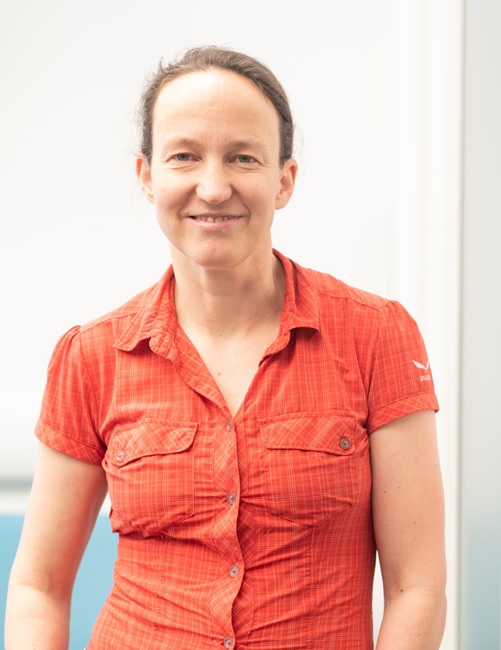Anne Straube

Anne Straube - Professor
Centre for Mechanochemical Cell Biology
Tel 024 761 51169 | Email A.Straube@warwick.ac.uk
After training in Biochemistry and Cell Biology in Hamburg, Marburg and Edinburgh, I started my own research group to investigate intracellular transport and cytoskeletal self-organisation at the Marie Curie Research Institute (MCRI) in Oxted, Surrey in 2007. I co-founded the Centre for Mechanochemical Cell Biology at the University of Warwick in 2010 together with Rob Cross and Andrew McAinsh. I have been awarded a Lister Institute Research Prize in 2013 and Wellcome Investigator Awards in 2016 and 2022. I was the Director of Warwick Biomedical Sciences from 2022 to 2025.
Plain English
For cells to retain and change their shape, protein filaments inside the cell are assembled into ordered arrangements. One type of such protein filaments, called microtubules, acts both as a skeleton providing mechanical stability and as the main transport highways to deliver cargo to specific regions of the cell. Thus how the microtubules are arranged inside the cell is important for their function. Work in my laboratory aims to understand in detail the molecular machines that organise and move the microtubules and cargoes inside cells. This is critical to understand neurological diseases that occur when transport processes are unbalanced.
Technical Summary
Microtubules are essential for chromosome segregation, intracellular transport, positioning of organelles, directed cell migration and differentiation. All these processes require the organisation of microtubules into arrays with different geometry and density and the proper regulation of dynamics and interactions at the microtubule ends. My lab focuses on the mechanisms that generate specific microtubule arrays in polarised cells, the dynamic interactions of microtubule tips with intracellular structures and the cell cortex and the intracellular cargo transport along microtubules. To do this we combine quantitative live cell imaging approaches with in imaging-based biochemistry assays.
A major current focus of my lab is on the cellular function and regulation of molecular motors dynein and KIF1C. We identified KIF1C as a cell polarity regulator and elucidated its cargo-mediated activation mechanism. We found that KIF1C regulates the adhesion of extreme cell protrusions such as the tail of migrating cells by delivering integrins (Theisen et al 2012). Success in purifying functional, full-length recombinant motor proteins enabled significant progress in understanding the regulation and force generation of both KIF1C and dynein. We showed that KIF1C is a highly processive, dimeric motor that is regulated by the intramolecular interaction of its stalk and motor domains. The pseudophosphatase PTPN21 and cargo adapter Hook3 activate KIF1C by binding to the stalk (Siddiqui, Zwetsloot et al 2019). This clearly showed that KIF1C is a dimer autoinhibited by intramolecular interactions rather than undergoing a monomer to dimer transition as shown for other kinesin-3s. In addition, we are beginning to understand how KIF1C responds to force. In contrast to conventional kinesin-1, KIF1C has a higher propensity to slip backwards while remaining attached to the microtubule (Siddiqui at al 2022). We showed that full-length KIF1C can generate forces of several pN and force generation is severely affected by pathogenic mutations in KIF1C that cause hereditary spastic paraplegia. One of our key contributions, is the reconstitution of complexes of KIF1C, dynein, dynactin and hook3, which recapitulate co-dependence of opposite polarity motors for the first time in vitro. KIF1C activates dynein by opening the FHF cargo adapter and extends dynein runs by acting as a processivity factor (Abid Ali, Zwetsloot et al 2025).
Earlier notable contributions from my group are: Together with Andrew McAinsh and Jennifer Ross, we have shown both CLASP1 and uMAP4 prevent excessive dynein-driven astral microtubule movements and thereby ensure proper positioning of the mitotic spindle (Samora, Mogessie et al 2011). We identified a new isoform of MAP4, oMAP4 that organises the paraxial microtubule array in differentiating skeletal muscle cells by forming crosslinks between microtubules that resist motor forces (Mogessie et al 2015). In collaboration with Irina Kaverina, we have shown that CLASPs control both, the trafficking of the kinesin KIF1C (Efimova et al 2014) and the microtubule binding of EB proteins (Grimaldi et al 2014). We have reconstituted the spatially distinct tip tracking of mammalian EB1, EB2 and EB3 and discovered that they recognise the nucleotide state of both tubulins surrounding their binding site (Roth, Fitton et al 2019).
Selected publications:
Abid Ali, F.*, Zwetsloot, A.J.*, Stone, C.E., Morgan, T.E., Wademan, R.F., Carter, A.P.** and Straube, A.** (2025) KIF1C activates and extends dynein movement through the FHF cargo adaptor. Nature Structural and Molecular Biology, doi: 10.1038/s41594-024-01418-z
Siddiqui, N., Roth, D., Toleikis, A., Zwetsloot, A.J., Cross, R.A. and Straube, A. (2022) Force generation of KIF1C is impaired by pathogenic mutations. Current Biology 32(17): 3862-3870.e6
Siddiqui, N.*, Zwetsloot, A.J.*, Bachmann, A., Roth, D., Hussain, H., Brandt, J., Kaverina, Straube, A.* (2019) PTPN21 and Hook3 relieve KIF1C autoinhibition and activate intracellular transport. Nature Communications, Volume 10, Article number: 2693.
Roth, D.*, Fitton, B.P.*, Chmel, N., Wasiluk, N. and Straube, A. (2019) Spatial positioning of EB family proteins at microtubule tips involves distinct nucleotide-dependent binding properties. Journal of Cell Science 132, jcs219550.
Mogessie, B., Roth, D., Rahil, Z. and Straube, A. (2015) A novel isoform of MAP4 organises the paraxial microtubule array required for muscle cell differentiation. eLife 4, e05697.
Theisen, U., Straube, E. and Straube, A. (2012) Directional persistence of migrating cells requires Kif1C-mediated stabilisation of trailing adhesions. Developmental Cell 23, 1153-1166
Samora, C.P.*, Mogessie, B.*, Conway, L., Ross, J.L., Straube, A.** and McAinsh, A.D.** (2011). MAP4 and CLASP1 operate as a safety mechanism to maintain a stable spindle position in mitosis. Nature Cell Biology 13, 1040-1050.
Straube, A.** and Merdes A. (2007). EB3 regulates MT dynamics at the cell cortex and is required for myoblast elongation and fusion. Current Biology 17 (15), 1318-1325.


